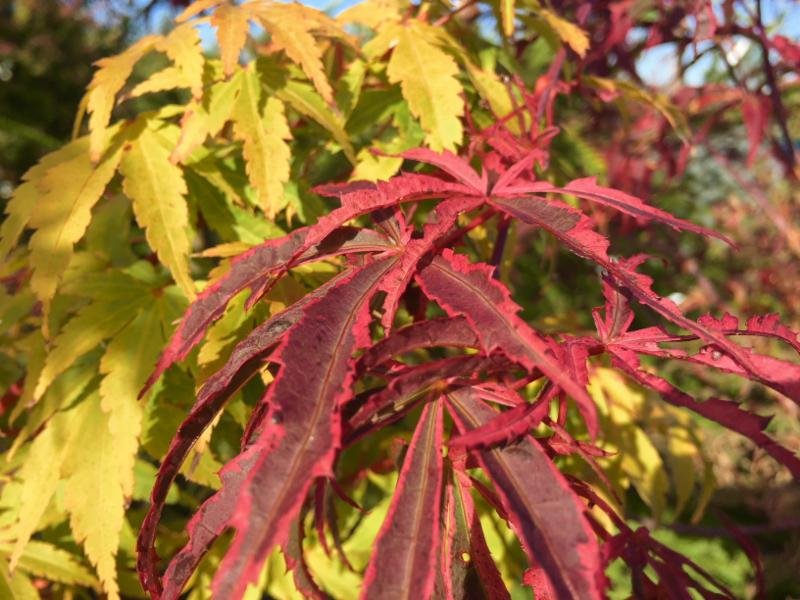One plant that simply must be present in every yard is a Laceleaf Japanese Maple. You know the ones… the beautiful, manageable sized trees that have interesting leaves in stunning colors all throughout the year. Laceleafs can be living art pieces when cared for properly and developed slowly into specimens that add character, texture, and color to any landscape. Even over the dormant winter months, a properly grown Laceleaf can be a stunning focal point in the garden.
Some of you are asking “Why the heck are you writing about Laceleafs in the winter?”, which is most certainly a valid question. My answer is simple - this is the time of year to get outside and get yours pruned before it leafs out! It is nearly impossible to properly prune one in the growing season when it is full of foliage, so getting them done now is both timely and ideal to achieve a tidy maple come spring. Try following these simple steps to help rejuvenate your specimen and give it a new lease on life. If you are overwhelmed with an old one and not sure where to start, snap a few cell phone pics and stop into a nursery to ask a local Professional Horticulturist for some advice.
First thing to do is to remove all the dead wood. If you look closely, you will see most of the branching underneath has died out and turned grey to beige color, not from disease but from age and a lack of sun. A Laceleaf grows each season by adding another layer weeping on top of the ones beneath. Before you know it, you may have a thick twiggy congested mess! Carefully cutting out this undergrowth will vastly improve the look and health of the tree and also help keep all fallen foliage from gathering amongst these twigs in autumn. Not sure if a branch is dead? Nick the bark with a fingernail and see if you find green cambium (healthy tissue) underneath. No green means branch goes, simple as that.
Once this is done, stand back to admire your work and then decide what else needs to be done. Simply cleaning out the dead wood makes a huge difference to most, but now your personal taste comes into play. Do you want a more open layered specimen? Or one that is a bit thicker? I prefer a more open look, so I will immediately do some additional thinning out of branches, starting at one spot and working around the plant in a circle, carefully pruning as I go. This involves carefully looking at structure and deciding which limbs are crossing over the next. With most any plant, these crossing limbs are a no-no for sure, but with Laceleafs they are not the end of the world. Again, it is your plant and your taste – open it up with some thinning or leave it alone, totally up to you.
Finally, you can view the perimeter of your Laceleaf and decide if some branches need to be headed back or shortened. Are branches weeping down onto the ground? Are they smothering other neighboring plants? All these limbs that are hanging too far down or out can be pruned on main branches to a point where side branches exist, and if done right you may not even notice. This allows both the new growth to be directed straight back down creating a full specimen, and it buys you more time before it weeps back down to the soil level.
I am hoping this will help motivate you to get out there and spend a little time working on your specimen(s) this month. If you are looking to add one to your landscape, like with most plants these days, there is a sometimes an overwhelming amount of choice. It is a great time of year to plant as we head towards spring, and optimal selection for varieties and sizes at local nurseries will happen very soon. Many varieties look somewhat similar, but some offer unique coloration when sited in the landscape in the right place. If you want a few suggestions of some that are not the typical red or green foliage, consider some flavors like 'Otto’s Dissectum’, ‘Orangeola’, ‘Ice Dragon’, and ‘Baldsmith'. All Laceleafs will sport stunning fall color, but many like these also have surprisingly bright spring foliage, which morphs into different colors in summer as well. When properly pruned, they will give you a unique specimen to admire in the landscape for decades to come.
Sadly, it is time for us to say goodbye to weekly columns from Steve, The Whistling Gardener. He has graciously taught us so much and entertained us with his knowledgeable, and often humorous, columns over the last 30+ years. While we congratulate him on his official retirement, we know he will likely still pop up every once in a while as a guest columnist and will still probably be heard whistling around Sunnyside Nursery. As one chapter closes, another one opens… We at Sunnyside are very excited to continue our weekly columns with the newly dubbed Golfing Gardener, Trevor Cameron! Trevor is a longtime gardener/plant enthusiast, a certified professional horticulturist and Sunnyside Nursery’s General Manager. Stay tuned for new plant passions, down-to-earth advice, and timely gardening tips. Cheers to many more years of helpful knowledge from your friends at Sunnyside, your local neighborhood nursery.



